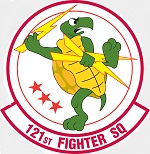JC Wings JCW72F16016 USAF General Dynamics F-16C Viper Fighter - 121st Fighter Squadron "Capital Guardians", 113th Fighter Wing, Joint Base Andrews, Camp Springs, Maryland, 2011 (1:72 Scale)
"Obsolete weapons do not deter."
- British Prime Minister Margaret Thatcher
 Even at the ripe old age of 20, the F-16 Falcon remains a fast and potent favorite among fighter pilots, and one of the best fighters in its class. Designed originally as a no-frills, single-engine "hot rod", the addition of improved radar and weaponry have made the Falcon a super, lightweight jet. Used mainly as a bomber, the Fighting Falcon can also turn-and-burn with unbridled fury when provoked. It is also one of the first operational fly-by-wire aircraft; its flight controls being electronically operated and computer controlled. A 20mm cannon, Maverick missiles, and laser-guided bombs make the F-16 a potent multi-role fighter. However, it's light weight, speed and agility make it the choice of the US Air Force's Thunderbirds aerobatic team.
Even at the ripe old age of 20, the F-16 Falcon remains a fast and potent favorite among fighter pilots, and one of the best fighters in its class. Designed originally as a no-frills, single-engine "hot rod", the addition of improved radar and weaponry have made the Falcon a super, lightweight jet. Used mainly as a bomber, the Fighting Falcon can also turn-and-burn with unbridled fury when provoked. It is also one of the first operational fly-by-wire aircraft; its flight controls being electronically operated and computer controlled. A 20mm cannon, Maverick missiles, and laser-guided bombs make the F-16 a potent multi-role fighter. However, it's light weight, speed and agility make it the choice of the US Air Force's Thunderbirds aerobatic team.
The F-16C (single seat) and F-16D (two seat) variants entered production in 1984. The first C/D version was the Block 25 with improved cockpit avionics and radar which added all-weather capability with beyond-visual-range (BVR) AIM-7 and AIM-120 air-air missiles. Block 30/32, 40/42, and 50/52 were later C/D versions. The F-16C/D had a unit cost of US$18.8 million (1998). Operational cost per flight hour has been estimated at $7,000 to $22,470 or $24,000, depending on calculation method.
Pictured here is a gorgeous 1:72 scale diecast replica of a USAF General Dynamics F-16C Viper fighter that was attached to the 121st Fighter Squadron "Capital Guardians", 113th Fighter Wing, then deployed to Joint Base Andrews, Camp Springs, Maryland, during 2011.
Now in stock!
Dimensions:
Wingspan: 7-inches
Length: 8-inches
Release Date: February 2023
 Historical Account: "Aviation Packages" - The 121st Fighter Squadron (121 FS) is a unit of the District of Columbia Air National Guard 113th Wing located at Joint Base Andrews, Camp Springs, Maryland. The 121st is equipped with the Block 30 F-16C/D Fighting Falcon.
Historical Account: "Aviation Packages" - The 121st Fighter Squadron (121 FS) is a unit of the District of Columbia Air National Guard 113th Wing located at Joint Base Andrews, Camp Springs, Maryland. The 121st is equipped with the Block 30 F-16C/D Fighting Falcon.
The squadron is a descendant organization of the 121st Observation Squadron, established on 10 July 1940. It is one of the 29 original National Guard Observation Squadrons of the United States Army National Guard formed before World War II.
In 1994, the 121st traded its early F-16A aircraft for Block 30 F-16C/D Fighting Falcon which upgraded its capabilities considerably. In May 1996, the 121st Fighter Squadron deployed personnel and aircraft to Al Jaber Air Base, Kuwait to support Operation Southern Watch (OSW). The 121st FS was the first Air National Guard unit to fly OSW. Operation Southern Watch was an operation which was responsible for enforcing the United Nations mandated no-fly zone below the 32nd parallel north in Iraq. This mission was initiated mainly to cover for attacks of Iraqi forces on the Iraqi Shi'ite Muslims. In July 1996, the squadron returned to Andrews AFB.
In mid-1996, the Air Force, in response to budget cuts, and changing world situations, began experimenting with Air Expeditionary organizations. The Air Expeditionary Force (AEF) concept was developed that would mix Active-Duty, Reserve and Air National Guard elements into a combined force. Instead of entire permanent units deploying as "Provisional" as in the 1991 Gulf War, Expeditionary units are composed of "aviation packages" from several wings, including active-duty Air Force, the Air Force Reserve Command and the Air National Guard, would be married together to carry out the assigned deployment rotation.
In February 1997, the 121st Expeditionary Fighter Squadron (121st EFS) was first formed from 113th personnel and aircraft and deployed to Incirlik Air Base, Turkey in support of Operation Northern Watch (ONW). Operation Northern Watch was a US European Command Combined Task Force (CTF) who was responsible for enforcing the United Nations mandated no-fly zone above the 36th parallel north in Iraq. This mission was a successor to Operation Provide Comfort which also entailed support for the Iraqi Kurds. The 121st EFS returned to Andrews in April 1997. The 121st EFS was again formed in January 1998 when the Wing was tasked with a second Operation Northern Watch deployment to Incirlik Air Base. This time the deployment was only for a month with less than 100 personnel being deployed.
On September 11th, 2001, the wing was given authorization to shoot down threatening aircraft over Washington DC.


